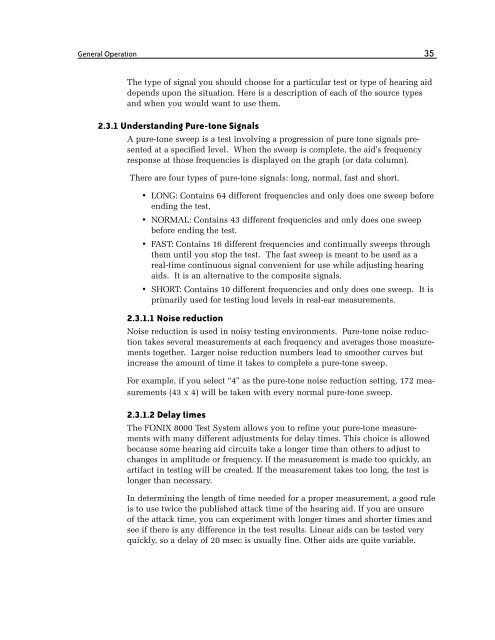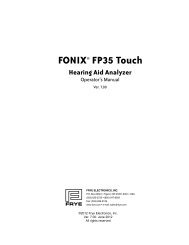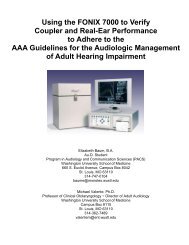FONIX® 8000 - Frye Electronics
FONIX® 8000 - Frye Electronics
FONIX® 8000 - Frye Electronics
You also want an ePaper? Increase the reach of your titles
YUMPU automatically turns print PDFs into web optimized ePapers that Google loves.
General Operation 35<br />
The type of signal you should choose for a particular test or type of hearing aid<br />
depends upon the situation. Here is a description of each of the source types<br />
and when you would want to use them.<br />
2.3.1 Understanding Pure-tone Signals<br />
A pure-tone sweep is a test involving a progression of pure tone signals presented<br />
at a specified level. When the sweep is complete, the aid’s frequency<br />
response at those frequencies is displayed on the graph (or data column).<br />
There are four types of pure-tone signals: long, normal, fast and short.<br />
• LONG: Contains 64 different frequencies and only does one sweep before<br />
ending the test.<br />
• NORMAL: Contains 43 different frequencies and only does one sweep<br />
before ending the test.<br />
• FAST: Contains 16 different frequencies and continually sweeps through<br />
them until you stop the test. The fast sweep is meant to be used as a<br />
real-time continuous signal convenient for use while adjusting hearing<br />
aids. It is an alternative to the composite signals.<br />
• SHORT: Contains 10 different frequencies and only does one sweep. It is<br />
primarily used for testing loud levels in real-ear measurements.<br />
2.3.1.1 Noise reduction<br />
Noise reduction is used in noisy testing environments. Pure-tone noise reduction<br />
takes several measurements at each frequency and averages those measurements<br />
together. Larger noise reduction numbers lead to smoother curves but<br />
increase the amount of time it takes to complete a pure-tone sweep.<br />
For example, if you select “4” as the pure-tone noise reduction setting, 172 measurements<br />
(43 x 4) will be taken with every normal pure-tone sweep.<br />
2.3.1.2 Delay times<br />
The FONIX <strong>8000</strong> Test System allows you to refine your pure-tone measurements<br />
with many different adjustments for delay times. This choice is allowed<br />
because some hearing aid circuits take a longer time than others to adjust to<br />
changes in amplitude or frequency. If the measurement is made too quickly, an<br />
artifact in testing will be created. If the measurement takes too long, the test is<br />
longer than necessary.<br />
In determining the length of time needed for a proper measurement, a good rule<br />
is to use twice the published attack time of the hearing aid. If you are unsure<br />
of the attack time, you can experiment with longer times and shorter times and<br />
see if there is any difference in the test results. Linear aids can be tested very<br />
quickly, so a delay of 20 msec is usually fine. Other aids are quite variable.
















